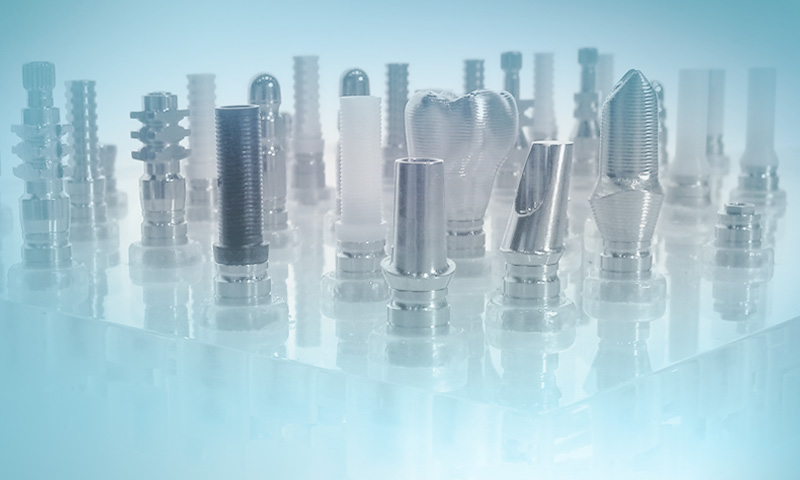

Of all the prosthetic solutions provided by AVINENT, the transepithelial abutment is one of the most welcome, valued products among its users. These types of abutments, which connect together the implant and the dental prosthesis (crown or bridge), share various features and benefits that help to improve precision and comfort in dental interventions, as well as avoiding possible complications for the patient.
According to Dr. Eduardo Duarte Marrero, an AVINENT user since 2012, these abutments “are very useful in solving various prosthetic complications such as implant depth or the fact that you can adjust unevenness”.
A host of prosthetic solutions
The main function of transepithelial abutments is to provide all manner of prosthetic solutions. Their two main features are principally their ability to superficialize the insertion axis of the implant and correct angulation. As Dr. Rafael García Rebollar explains: “These devices can correct the insertion axis of the prosthesis-implant connection and help to insert and fit the prosthesis in a very precise manner.”
Not all dental professionals began their careers using transepithelial abutments, as is the case of Dr. Albert Calaf, who claims that “at first, I thought the simpler the things, the better,” which is why he had become used to screwing the prosthesis directly into the implant. However, he soon included abutments in his interventions: “When I started to deal with cases of periimplantitis, I wondered what I could do to minimize any problems and one solution was to start using transepithelial abutments whenever I restored multiple implants.” According to Calaf, the main benefits of these prosthetic devices are “less inflammation of the peri-implant tissue and reduced risk of periimplantitis, minimizing patient discomfort when making impressions and trial prostheses, as well as the possibility of choosing height and correcting angulations”.

Correcting unevenness and angulations in the dental arch is indeed one of the main functions of transepithelial abutments. Obvious examples of this are the “all-on-four” cases, in which the implants are positioned at 45 degrees and correcting the axis of the prosthesis is required, which can be achieved with transepithelial abutments. Another case is that of bone atrophy, in which the implants are buried at different levels. As Dr. Duarte explains: “If bone conditions are inadequate, the transepithelial abutment provides you with the ability to correct angulation and height, thereby being able to adapt the prosthesis you want to position correctly and precisely.”

Furthermore, in cases where there are angulation differences of 20 degrees between implants, depending on the connection (geometry) and the implant, the screwed prostheses cannot be placed and removed properly. Transepithelial abutments can correct these variations in such cases, thereby solving the problem of the insertion axis of the prosthesis and helping to position and remove it very easily.
Another feature of these abutments can be seen in cases involving the positioning of single-unit prostheses in which the implant is highly submerged. In such cases, transepithelial abutments help to correct this biological width and, consequently, improve crown positioning and soft tissue adaptation.
Exact precision between abutment and prosthesis
A perfect fit in the implant-prosthesis connection is one of the priorities for dentists. “It is very important for transepithelial abutments to provide this precision, as it cannot be achieved by screwing the prosthesis directly into the implant or through CAD/CAM processes. It can perhaps be achieved through intraoral scans, but errors may occur as long as impressions are made in the traditional way,” explains Dr. Albert Calaf.

For his part, Dr. Juan Ferreira explains that AVINENT has achieved mechanical and hygienic benefits with these transepithelial abutments: “We found that the connection remains flawless when removing it after a long period of time,” adding that “the fact that the connection is of such precision is the key to preventing bacterial leakage, which may lead to gum inflammation.”

An extensive system of high quality transepithelial abutments
In terms of products, AVINENT produces three types of transepithelial abutments: straight uniblock, two-piece straight for single-unit prostheses and, finally, two-piece straight circular. They all range from between 0.5 mm and 5 mm in height and in the case of the angled types an angulation capacity of 17, 24 and 30 degrees, with a varying height of between 2 mm and 5 mm. As regards the type of connection, external connection (EC), internal connection (IC) and conical connection (CC) types are available.
All of AVINENT’s transepithelial abutments and final screws are manufactured in Ti Grade V ELI (6Al-4V) , which increases their capacity to flex and adhere. In addition, the design of their impression abutment is also very welcome: “It greatly helps to make an impression and locate the screw better,” explains Dr. Ferreira.

All of AVINENT’s transepithelial abutments use a carrier piece to help position the implant. In the case of the conical connections, these carrier pieces are the same color as the platform to reduce error and make them easier to use.
Dr. García Rebollar concludes: “The great benefit of transepithelial abutments is, above all, their comfort and safety by using the original abutments. Precision in interventions is undoubtedly much higher and risks are reduced when this device is used. The results make it all very worthwhile.”